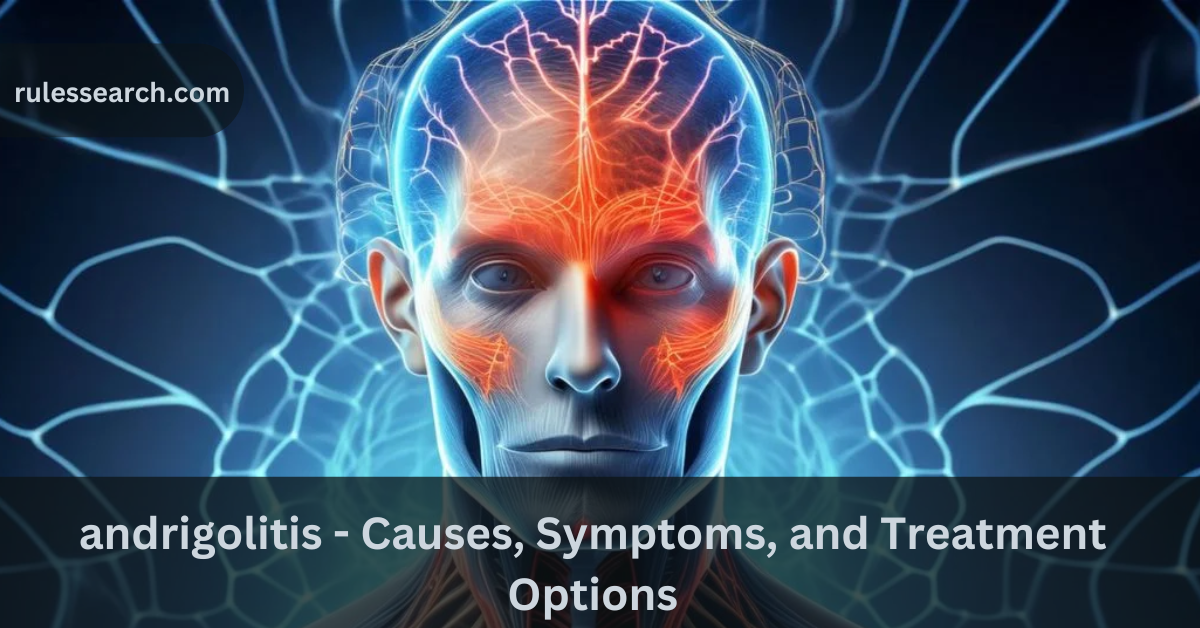Andrigolitis is a multifaceted medical condition that affects various systems within the human body, leading to a broad spectrum of symptoms and complications. Although it might not be a widely recognized term, andrigolitis can have significant impacts on an individual’s health and quality of life. This article aims to provide a comprehensive overview of andrigolitis, exploring its causes, symptoms, and treatment options, along with detailed insights and analyses for those looking to understand this condition better.
What is Andrigolitis?
Andrigolitis is a chronic inflammatory condition that primarily affects the body’s connective tissues, but it can also involve multiple organ systems. The inflammation triggered by andrigolitis can cause a cascade of health issues, ranging from mild discomfort to severe, life-threatening complications. The exact mechanisms behind the development of andrigolitis are still under research, but it is believed to be an autoimmune disorder, where the body’s immune system mistakenly attacks its own tissues.
Causes of Andrigolitis
The causes of andrigolitis are complex and not fully understood. However, several factors are believed to contribute to the onset of this condition:
- Genetic Predisposition: A family history of autoimmune diseases may increase the likelihood of developing andrigolitis. Certain genetic markers have been linked to a higher risk of autoimmune responses that could lead to this condition.
- Environmental Triggers: Exposure to specific environmental factors, such as infections, toxins, or certain medications, may trigger the onset of andrigolitis in individuals who are genetically predisposed.
- Immune System Dysregulation: In andrigolitis, the immune system becomes hyperactive and starts attacking healthy tissue, leading to inflammation and damage. This dysregulation is often linked to autoimmune processes.
Symptoms of Andrigolitis
The symptoms of andrigolitis can vary widely depending on the severity of the condition and the specific systems affected. Common symptoms include:
- Joint Pain and Stiffness: Chronic inflammation can lead to significant pain and stiffness in the joints, often resembling symptoms of rheumatoid arthritis.
- Fatigue: Persistent fatigue is a common symptom of andrigolitis, often exacerbated by the body’s constant battle with inflammation.
- Skin Lesions: In some cases, individuals with andrigolitis may develop skin lesions or rashes, particularly in areas where the inflammation is most active.
- Organ Involvement: Severe cases of andrigolitis can affect vital organs, including the lungs, heart, and kidneys, leading to serious complications such as organ failure.
Diagnosing Andrigolitis
Diagnosing andrigolitis can be challenging due to its varied symptoms and the overlap with other autoimmune disorders. A thorough medical evaluation typically includes:
- Medical History Review: A detailed review of the patient’s medical history, including any family history of autoimmune diseases, is crucial.
- Physical Examination: A comprehensive physical examination helps identify specific symptoms related to andrigolitis, such as joint tenderness or skin abnormalities.
- Laboratory Tests: Blood tests to measure markers of inflammation, autoimmune antibodies, and organ function are commonly used to support the diagnosis.
- Imaging Studies: Imaging techniques such as X-rays, MRIs, or ultrasounds may be used to assess the extent of inflammation and organ involvement.
Treatment Options for Andrigolitis
The treatment of andrigolitis focuses on managing symptoms, reducing inflammation, and preventing complications. Treatment plans are often tailored to the individual’s specific needs and may include:
- Medications:
- Anti-Inflammatory Drugs: Nonsteroidal anti-inflammatory drugs (NSAIDs) are often prescribed to reduce inflammation and alleviate pain.
- Corticosteroids: These powerful anti-inflammatory medications may be used in more severe cases to control symptoms.
- Immunosuppressants: Medications that suppress the immune system can help reduce the autoimmune response, slowing the progression of andrigolitis.
- Physical Therapy: Regular physical therapy can help maintain joint mobility and strength, reducing the impact of joint stiffness and pain.
- Lifestyle Modifications:
- Dietary Changes: A balanced diet rich in anti-inflammatory foods may help manage symptoms.
- Exercise: Regular, low-impact exercise can help reduce joint pain and improve overall well-being.
- Stress Management: Stress has been shown to exacerbate autoimmune conditions, so practices such as yoga, meditation, or counseling may be beneficial.
- Surgical Intervention: In cases where andrigolitis leads to significant joint damage or organ complications, surgical interventions such as joint replacement or organ transplants may be necessary.
Living with Andrigolitis
Living with andrigolitis can be challenging, but with proper management, many individuals can lead fulfilling lives. Key strategies for living with this condition include:
- Regular Medical Follow-ups: Ongoing monitoring by healthcare professionals is essential to adjust treatment plans as needed and to catch potential complications early.
- Support Systems: Building a support network, including family, friends, and support groups, can provide emotional and practical assistance.
- Education and Awareness: Understanding andrigolitis and staying informed about the latest research and treatment options can empower individuals to take an active role in managing their condition.
Prognosis and Outlook
The prognosis for individuals with andrigolitis varies widely depending on the severity of the disease and the effectiveness of the treatment. While some people may experience only mild symptoms that are well-controlled with medication and lifestyle changes, others may face more severe challenges that require intensive medical intervention. Early diagnosis and a proactive approach to treatment are critical in improving the long-term outlook for those affected by andrigolitis.
Conclusion
Andrigolitis is a complex and potentially debilitating condition, but with the right care and management strategies, individuals can navigate the challenges it presents. By understanding the causes, symptoms, and treatment options available, those affected by andrigolitis can take steps to improve their quality of life and reduce the impact of the disease.
Frequently Asked Questions (FAQs)
What causes andrigolitis?
The exact cause of andrigolitis is not fully understood, but it is believed to result from a combination of genetic predisposition, environmental triggers, and immune system dysregulation.
What are the common symptoms of andrigolitis?
Common symptoms include joint pain and stiffness, fatigue, skin lesions, and in severe cases, organ involvement such as lung, heart, or kidney issues.
How is andrigolitis diagnosed?
Diagnosis typically involves a review of medical history, a physical examination, blood tests for inflammation and autoimmune markers, and imaging studies to assess the extent of the disease.
What treatment options are available for andrigolitis?
Treatment options include medications like NSAIDs, corticosteroids, and immunosuppressants, physical therapy, lifestyle modifications, and in severe cases, surgical intervention.
Can diet and lifestyle changes help manage andrigolitis?
Yes, dietary changes to include anti-inflammatory foods, regular exercise, and stress management practices can help manage symptoms and improve overall health.
Is andrigolitis a life-threatening condition?
While andrigolitis can lead to severe complications, particularly if vital organs are involved, early diagnosis and appropriate treatment can significantly improve the prognosis.
Are there any support groups for people with andrigolitis?
Yes, many online and local support groups are available for individuals with autoimmune conditions, including andrigolitis, providing emotional support and practical advice.
What is the long-term outlook for someone with andrigolitis?
The long-term outlook varies, but with effective treatment, many people can manage their symptoms and lead relatively normal lives. Early intervention is key to improving outcomes.
Can andrigolitis be cured?
There is currently no cure for andrigolitis, but treatment can effectively manage symptoms and reduce the risk of complications.
What should I do if I suspect I have andrigolitis?
If you suspect you have symptoms of andrigolitis, it is important to consult a healthcare professional for a thorough evaluation and appropriate testing. Early diagnosis can help manage the condition more effectively.



